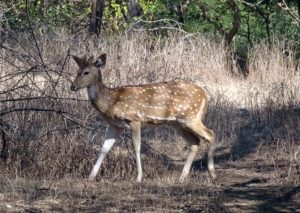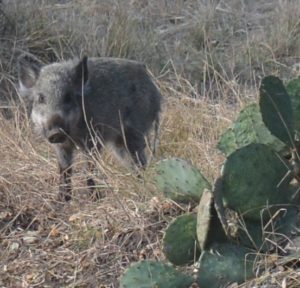Summary
Current Research
Our research aims to identify strategic research priorities in the conservation and management of native, exotic and invasive wildlife populations at the livestock interface. An improved understanding of wildlife epidemiology will allow for the identification of intervention strategies which will in turn benefit wildlife health, agricultural productivity, biodiversity and human health.
Exotic ungulates, Bovine babesiosis, and tick vectors

-
-
- We aim to investigate the role of native and exotic wildlife species in the spread of cattle fever ticks (Rhipicephalus microplus and R. annulatus) and the potential reemergence of bovine babesiosis in the US. White-tailed deer (Odocoileus virginianus) and Nilgai antelope (Boselaphus tragocamelus) have been implicated in the movement of cattle fever ticks Rhipicephalus spp. in South Texas, but less is known regarding the role of other exotic species. A diverse array of exotic species including axis (Cervus axis), fallow (Cervus dama), red deer (Cervus elaphus), blackbuck (Antilope cervicapra), scimitar-horned oryx (Oryx dammah) and gemsbok (Oryx gazella) inhabit the northern reaches of the permanent quarantine area, which includes the South Texas Plains and southern Edwards Plateau. Abundance of these ungulate hosts has transformed the ecology of this disease system since it the disease was eradicated in the mid-1900s and this research will aim to improve our understanding of the potential role of these species in this vector-borne disease system.
-
Movement of vectors and disease-causing pathogens by feral hogs

Feral hogs (Sus scrofa) occupy most counties in Texas and move across the landscape with ease, providing an ideal opportunity for the movement of vectors and pathogens. The objective of this research is to quantify the involvement of invasive feral swine in the movement of vectors and disease-causing pathogens in the South Texas Plains and the Edwards Plateau.
Climate and vector-borne diseases

Climate, especially temperature and precipitation can have dramatic impacts on disease vectors including reproduction, survival, and biting rate, as well as influencing the survival and development rates of the pathogens that they carry. Characterizing the effects of climate and drought on vector-borne disease transmission is essential to informing the spread, emergence and maintenance of vector-borne diseases in Texas.
Interspecies Pathogen Transmission
Interactions between native, exotic and invasive species can have strong implications for interspecies pathogen transmission events. Gaining a better understanding of the interactions among and within these groups is imperative to defining the risks of interspecies pathogen transmission which may lead to emergence of pathogens and vectors in geographic locations and species not previously recognized.
Dr. Tammi Johnson
Team Members
- Kelly Persinger, Research Associate
- Geoff Lynn , Assistant Research Scientist
- Taylor Chapman – Graduate Assistant Research
- Teri Gaston, Animal Caretaker II
- Hailey Cook – Animal Caretaker I
Publications
- Paddock, CD, J Hecht, AN Green, KA Waldrup, PD Teel, SE Karpathy and TL Johnson. 2020. Rickettsia parkeri in the sky islands of West Texas. Journal of Medical Entomology.
- Johnson, TL, CB Graham, SE Maes, A Hojgaard, A Fleshman, KA Boegler, MJ Delorey, KS Slater, SE Karpathy, JKH Bjork, DF Neitzel, EK Schiffman, and RJ Eisen. 2018. Prevalence and distribution of seven human pathogens in host-seeking Ixodes scapularis (Acari: Ixodidae) nymphs in Minnesota, USA. Ticks and Tick-borne Diseases, 9(6):1499-1507.
- Johnson, TL, JKH Bjork, KA Boegler, RJ Clark, MJ Delorey, FM Door, AJ Monaghan, DF Neitzel, EK Schiffman, and RJ Eisen. 2018. An acarological risk model predicting the density and distribution of host-seeking Ixodes scapularis nymphs in Minnesota, USA. American Journal of Tropical Medicine and Hygiene, 98(6):1671-1682.
- Sage, KM*, TL Johnson*, MB Teglas, NC Nieto, and TG Schwan. 2017. Ecological niche modeling of the distribution of tick-borne relapsing fever in western North America. PLoS Neglected Tropical Diseases, 11(10):e0006047. *denotes equal contribution and shared first-authorship
- Johnson, TL, CB Graham, A Hojgaard, NE Breuner, SE Maes, KA Boegler, AJ Replogle, LC Kingry, JM Petersen, L Eisen, and RJ Eisen. 2017. Isolation of the Lyme Disease Spirochete Borrelia mayonii from Naturally Infected Rodents in Minnesota. Journal of Medical Entomology, 54(4):1088-1092.
- Johnson, TL, RJ Fischer, SJ Raffel, and TG Schwan. 2016. Host associations and genomic diversity of Borrelia hermsii in an endemic focus of tick-borne relapsing fever in Western North America. Parasites and Vectors, 9:575
- Johnson, TL, E Stone, and EL Landguth. 2016. Modeling Relapsing Disease Dynamics in a Host-vector Community. PLoS Neglected Tropical Diseases 10(2):e0004428.
- Johnson, TL, JKH Bjork, DF Neitzel, FM Dorr, EK Schiffman, and RJ Eisen. 2016. Habitat suitability model for the distribution of black-legged ticks, Ixodes scapularis (Acari: Ixodidae), in Minnesota. Journal of Medical Entomology 53(3):598-606.
- Johnson, TL, JF Cully, Jr., SK Collinge, C Ray, CM Frey, and BK Sandercock. 2011. Spread of sylvatic plague among black-tailed prairie dogs is associated with colony spatial characteristics. Journal of Wildlife Management 75(2):357-368.
- Cully, JF, Jr.*, TL Johnson*, SK Collinge, and C Ray. 2010. Disease limits populations: plague and black-tailed prairie dogs. Vector-borne Zoonotic Diseases 10(1):7-15.*denotes equal contribution and shared first- authorship
- Fischer, RJ, TL Johnson, SJ Raffel, and TG Schwan. 2009. Identical strains of Borrelia hermsii in mammal and bird. Emerging Infectious Diseases 15(12):2064-2066.
Grants
- Grant #1



